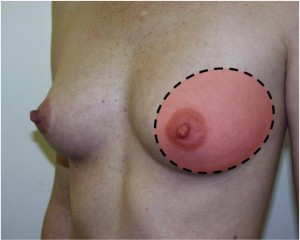Cyclic breast pain is usually most prominent in the upper, outer quadrant, and in the areolar areas.

For some women, cyclic breast pain and tenderness (mastodynia or cyclic mastalgia) accompanies the later portions of the menstrual cycle. Typically for several days preceding the menstrual flow, the breasts of these women enlarge, become lumpy, tender to touch, and produce a generalized aching. The nipples may become extremely sensitive and very uncomfortable. This condition is sometimes called fibrocystic breast disease, fibrocystic breast changes, or cyclic mastalgia.
Very mild cases of mastodynia can be treated with mild analgesics and reassurance. The more severe forms respond well to a number of medication; The simplest of these is BCPs.
After starting low-dose, monophasic BCPs, the cyclic breast pain is usually immediately improved to some extent. In the months and years to come, the breasts usually become progressively less lumpy, less tender and less uncomfortable. BCPs are a very effective long-term treatment for this problem.
Also effective is the use of Danazol. Unfortunately, Danazol (800 mg/day) is expensive, not often available in operational settings, and has many significant side effects (unwanted hair growth, deepening of the voice, weight gain, clitoral hypertrophy, and others), which limit its’ usefulness.
If these medications are unavailable, probably any medication which disrupts ovulation, such as Lupron, or DEPO-PROVERA, will be reasonably effective in stopping the cyclic breast pain that is so annoying to some women.
